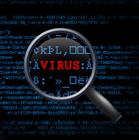簡介
最早由馮·諾伊曼提出一種可能性----現在稱為病毒,但沒引起注意。1975 年,美國科普作家約翰·布魯勒爾 (John Brunner) 寫了一本名為《震盪波騎士》(Shock Wave Rider) 的書,該書第一次描寫了在信息社會中,計算機作為正義和邪惡雙方鬥爭的工具的故事,成為當年最佳暢銷書之一。
1977 年夏天,托馬斯·捷·瑞安 (Thomas.J.Ryan) 的科幻小說《P-1的春天》(The Adolescence of P-1) 成為美國的暢銷書,作者在這本書中描寫了一種可以在計算機中互相傳染的病毒,病毒最後控制了 7,000 台計算機,造成了一場災難。
1983 年 11 月 3 日,弗雷德·科恩 (Fred Cohen) 博士研製出一種在運行過程中可以複製自身的破壞性程式,倫·艾德勒曼 (Len Adleman) 將它命名為計算機病毒(computer viruses),並在每周一次的計算機安全討論會上正式提出,8 小時後專家們在 VAX11/750 計算機系統上運行,第一個病毒實驗成功,一周后又獲準進行 5 個實驗的演示,從而在實驗上驗證了計算機病毒的存在。
1986 年初,在巴基斯坦的拉合爾 (Lahore),巴錫特 (Basit) 和阿姆傑德(Amjad) 兩兄弟經營著一家 IBM-PC 機及其兼容機的小商店。他們編寫了Pakistan 病毒,即Brain。在一年內流傳到了世界各地。
1988 年 3 月 2 日,一種蘋果機的病毒發作,這天受感染的蘋果機停止工作,只顯示“向所有蘋果電腦的使用者宣布和平的信息”。以慶祝蘋果機生日。
1988 年 11 月 2 日,美國六千多台計算機被病毒感染,造成 Internet不能正常運行。這是一次非常典型的計算機病毒入侵計算機網路的事件,迫使美國政府立即作出反應,國防部成立了計算機應急行動小組。這次事件中遭受攻擊的包括 5 個計算機中心和 12 個地區結點,連線著政府、大學、研究所和擁有政府契約的 250,000 台計算機。這次病毒事件,計算機系統直接經濟損失達 9600 萬美元。這個病毒程式設計者是羅伯特·莫里斯 (Robert T.Morris),當年 23 歲,是在康乃爾 (Cornell) 大學攻讀學位的研究生。
羅伯特·莫里斯設計的病毒程式利用了系統存在的弱點。由於羅伯特·莫里斯成了入侵 ARPANET 網的最大的電子入侵者,而獲準參加康乃爾大學的畢業設計,並獲得哈佛大學 Aiken 中心超級用戶的特權。他也因此被判 3 年緩刑,罰款 1 萬美元,他還被命令進行 400 小時的新區服務。
1988 年底,在我國的國家統計部門發現小球病毒。
註:在此文中,把蠕蟲、我們常提的病毒定為病毒不同種類。
l 重溫電腦病毒史
你可知道,電腦病毒的概念來自一場遊戲?
電腦病毒的起源
電腦病毒的概念其實源起相當早,在第一部商用電腦出現之前好幾年時,電腦的先驅者馮·諾伊曼(John Von Neumann)在他的一篇論文《複雜自動裝置的理論及組識的進行》里,已經勾勒出病毒程式的藍圖。不過在當時,絕大部分的電腦專家都無法想像會有這種能自我繁殖的程式。1975年,美國科普作家約翰·布魯勒爾(John Brunner)寫了一本名為《震盪波騎士》(Shock Wave Rider)的書,該書第一次描寫了在信息社會中,計算機作為正義和邪惡雙方鬥爭的工具的故事,成為當年最佳暢銷書之一。
1977年夏天,托馬斯·捷·瑞安(Thomas.J.Ryan)的科幻小說《P-1的春天》(The Adolescence of P-1)成為美國的暢銷書,作者在這本書中描寫了一種可以在計算機中互相傳染的病毒,病毒最後控制了 7,000 台計算機,造成了一場災難。虛擬科幻小說世界中的東西,在幾年後終於逐漸開始成為電腦使用者的噩夢。
而差不多在同一時間,美國著名的AT&T貝爾實驗室中,三個年輕人在工作之餘,很無聊的玩起一種遊戲:彼此撰寫出能夠吃掉別人程式的程式來互相作戰。這個叫做"磁芯大戰"(core war)的遊戲,進一步將電腦病毒"感染性"的概念體現出來。
1983年11月3日,一位南加州大學的學生弗雷德·科恩(Fred Cohen)在UNIX系統下,寫了一個會引起系統當機的程式,但是這個程式並未引起一些教授的注意與認同。科恩為了證明其理論而將這些程式以論文發表,在當時引起了不小的震撼。科恩的程式,讓電腦病毒具備破壞性的概念具體成形。
不過,這種具備感染與破壞性的程式被真正稱之為"病毒",則是在兩年後的一本《科學美國人》的月刊中。一位叫作杜特尼(A.K.Dewdney)的專欄作家在討論"磁芯大戰"與蘋果二型電腦(別懷疑,當時流行的正是蘋果二型電腦,在那個時候,我們熟悉的PC根本還不見蹤影)時,開始把這種程式稱之為病毒。從此以後我們對於這種具備感染或破壞性的程式,終於有一個"病毒"的名字可以稱呼了。
第一個真正的電腦病毒
到了1987年,第一個電腦病毒C-BRAIN終於誕生了(這似乎不是一件值得慶賀的事)。一般而言,業界都公認這是真正具備完整特徵的電腦病毒始祖。這個病毒程式是由一對巴基斯坦兄弟:巴斯特(Basit)和阿姆捷特(Amjad)所寫的,他們在當地經營一家販賣個人電腦的商店,由於當地盜拷軟體的風氣非常盛行,因此他們的目的主要是為了防止他們的軟體被任意盜拷。只要有人盜拷他們的軟體,C-BRAIN就會發作,將盜拷者的硬碟剩餘空間給吃掉。這個病毒在當時並沒有太大的殺傷力,但後來一些有心人士以C-BRAIN為藍圖,製作出一些變形的病毒。而其他新的病毒創作,也紛紛出籠,不僅有個人創作,甚至出現不少創作集團(如NuKE,Phalcon/Skism,VDV)。各類掃毒、防毒與防毒軟體以及專業公司也紛紛出現。一時間,各種病毒創作與反病毒程式,不斷推陳出新,如同百家爭鳴。
DOS時代的著名病毒
所謂"DOS時代的病毒",意思是說這是從DOS時代就有的老古董,諸位讀者可別以為您現在已經進入Windows 95/98的年代,就不會感染DOS時期的病毒。其實由於Windows 95/98充其量不過是一套架構在DOS上的作業系統,因此即使是處在Windows 95/98之下,一不小心還是會惹火上身的!耶路撒冷(Jerusalem)
這個古董級病毒其實有個更廣為人知的別稱,叫做"黑色星期五"。為什麼會有這么有趣的別稱?道理很簡單:因為只要每逢十三號又是星期五的日子,這個病毒就會發作。而發作時將會終止所有使用者所執行的程式,症狀相當兇狠。米開朗基羅(Michelangelo)
米開朗基羅的名字,對於一些早一點的電腦使用者而言,真可說是大名鼎鼎,如雷貫耳。著名的原因除了它擁有一代藝術大師米開朗基羅的名字之外,更重要的是它的殺傷力驚人:每年到了3月6日米開朗基羅生日(這也就是它為什麼叫做"米開朗基羅"的原因)時,這個病毒就會以Format硬碟來為這位大師祝壽。於是乎,你辛苦建立的所有資料都毀於一旦,永無翻身之日。猴子(Monkey)
Monkey據說是第一個"引導型"的病毒,只要你使用被Monkey感染過的系統軟碟開機,病毒就會入侵到你的電腦中,然後伺機移走硬碟的分區表,讓你一開機就會出現"Invalid drive specification"的信息。比起"檔案型"病毒只有執行過受感染檔案才會中毒的途徑而言,Monkey的確是更為難纏了。音樂蟲病毒(Music Bug)
這個發作時會大聲唱歌,甚至造成資料流失、無法開機的病毒,正是台灣土產的病毒。所以,當你聽到電腦自動傳來一陣陣音樂聲時,別以為你的電腦比別人聰明,那很有可能是中毒了。其實這種會唱歌的病毒也不少,有另一個著名的病毒(叫什麼名字倒忘了)發作時還會高唱著"兩隻老虎"呢!
DOS時期的病毒,種類相當繁雜,而且不斷有人改寫現有的病毒。到了後期甚至有人寫出所謂的"雙體引擎",可以把一種病毒創造出更多元化的面貌,讓人防不勝防!而病毒發作的症狀更是各式各樣,有的會唱歌、有的會刪除檔案、有的會Format硬碟、有的還會在螢幕上顯出各式各樣的圖形與音效。不過幸運的是,這些DOS時期的古董級病毒,由於大部分的防毒軟體都可以輕易地掃除,所以殺傷力已經大不如前了。
Windows時期的來臨
隨著Windows 3.1在全球的風行,正式宣告了個人電腦操作環境進入Windows時代。緊接著,Windows 95/98的大為暢銷,使得現在幾乎所有個人電腦的操作環境都是在Windows狀態下。而在Windows環境下最為知名的,大概就屬"宏病毒"與 "32位病毒"了。宏病毒
隨著各種Windows下套裝軟體的發展,許多軟體開始提供所謂"宏"的功能,讓使用者可以用"創造宏"的方式,將一些繁瑣的過程記錄成一個簡單的指令來方便自己操作。然而這種方便的功能,在經過有心人士的設計之後,終於又使得"檔案型"病毒進入一個新的里程碑:傳統的檔案型病毒只會感染後綴為exe和 com的執行檔案,而宏病毒則會感染Word、Excel、AmiPro、Access等軟體儲存的資料檔案。更誇張的是,這種宏病毒是跨操作平台的。以 Word的宏病毒為例,它可以感染DOS、Windows 3.1/95/98/NT、OS/2、麥金塔等等系統上的Word檔案以及通用模板。在這些宏病毒之中,最為有名的除了後面要講的Melissa就是令人聞之色變的Taiwan NO.1B 。這個病毒的發作情形是:到了每月的十三號,只要您隨便開啟一份Word檔案,螢幕上會出現一對話視窗,詢問你一道龐雜的算數題。答錯的話(這種複雜的算數大概只有超人可以很快算出來吧)就會連續開啟二十個視窗,然後又出現另一道問題,如此重複下去,直到耗盡系統資源而當機為止。
雖然宏病毒有很高的傳染力,但幸運的是它的破壞能力並不太強,而且解毒方式也較容易,甚至不需防毒軟體就可以自行手動解毒。
32位病毒
所謂"32位病毒",則是在Windows 95之後所產生的一種新型態檔案型病毒,它雖然同樣是感染exe執行檔案,但是這種病毒專挑Windows的32位程式下手,其中最著名的就是去年大為流行的CIH病毒了。CIH病毒的厲害之處,在於他可以把自己的本體拆散塞在被感染的檔案中,因此受感染的檔案大小不會有所變化,防毒軟體也不易察覺。而最後一個版本的CIH 病毒,除了每個月26日發作,將你的硬碟Format掉之外,有時候還會破壞主機板BIOS內的資料,讓你根本無法開機!雖然目前大部分的防毒軟體都有最新的病毒碼可以解決這隻難纏的病毒,不過由於它的威力實在強大,大家還是小心為上。(CIH又可能在今年4月26發作,你不會有事吧?)
Internet的革命
有人說Internet的出現,引爆了新一波的信息革命。因為在網際網路上,人與人的距離被縮短到極小的距離,而各式各樣網站的建立以及搜尋引擎的運用,讓每個人都很容易從網路上獲得想要的信息。Internet的盛行造就了信息的大量流通,但對於有心散播病毒、盜取他人帳號、密碼的電腦黑客來說,網路不折不扣正好提供了一個絕佳的渠道。也因此,我們這些一般的使用者,雖然享受到網際網路帶來的方便,同時卻也陷入另一個恐懼之中。
病毒散播的新捷徑
由於網際網路的便利,病毒的傳染途徑更為多元化。傳統的病毒可能以磁碟或其他存儲媒體的方式散布,而現在,你只要在電子郵件或ICQ中,夾帶一個檔案寄給朋友,就可能把病毒傳染給他;甚至從網路上下載檔案,都可能收到一個含有病毒的檔案。不過雖然網路使得病毒的散布更為容易,但其實這種病毒還是屬於傳統型的,只要不隨便從一些籍籍無名的網站下載檔案(因為有名的網站為了不砸了自己的招牌,提供下載的檔案大都經過防毒處理),安裝防毒軟體,隨時更新病毒碼,下載後的檔案不要急著執行,先進行查毒的步驟(因為受傳統病毒感染的程式,只要不去執行就不會感染與發作),多半還是可以避免中毒的情形產生。
第二代病毒的崛起
前面所談的各式各樣的病毒,基本上都是屬於傳統型的病毒,也就是所謂"第一代病毒"。會有這樣的稱呼方式,主要是用來區分因為Internet蓬勃發展之後,最新出現的嶄新病毒。這種新出現的病毒,由於本質上與傳統病毒有很大的差異性,因此就有人將之稱為"第二代病毒"。第二代病毒與第一代病毒最大的差異,就是在於第二代病毒傳染的途徑是基於瀏覽器的,這種發展真是有點令人瞠目結舌!
原來,為了方便網頁設計者在網頁上能製造出更精彩的動畫,讓網頁能更有空間感,幾家大公司聯手制訂出Active X及Java的技術。而透過這些技術,甚至能夠分辨你使用的軟體版本,建議你應該下載哪些軟體來更新版本,對於大部分的一般使用者來說,是頗為方便的工具。但若想要讓這些網頁的動畫能夠正常執行,瀏覽器會自動將這些Active X及Java applets的程式下載到硬碟中。在這個過程中,惡性程式的開發者也就利用同樣的渠道,經由網路滲透到個人電腦之中了。這就是近來崛起的"第二代病毒 ",也就是所謂的"網路病毒"。
兵來將擋,水來土掩
目前常見的第二代病毒,其實破壞性都不大,例如在瀏覽器中不斷開啟視窗的"視窗炸彈",帶著電子計時器發出"咚咚"聲的"鬧鬧熊"等,只要把瀏覽器關閉後,對電腦並不會有任何影響。但隨著科技的日新月異,也難保不會出現更新、破壞性更大的病毒。只是,我們也不需要因為這種趨勢而太過悲觀,更不用因噎廢食地拒絕使用電腦上網。整個電腦發展史上,病毒與防毒軟體的對抗一直不斷的持續進行中,只要小心一點,還是可以愉快地暢遊在網際網路的世界裡。
整理自《PCHOME》及"病毒觀察"網站
電腦病毒發展歷史年表(英文)
1949Theories for self-replicating programs are first developed.
1981
Apple Viruses 1, 2, and 3 are some of the first viruses “in the wild,” or in the public domain. Found on the Apple II operating system, the viruses spread through Texas A&M via pirated computer games.1983
Fred Cohen, while working on his dissertation, formally defines a computer virus as “a computer program that can affect other computer programs by modifying them in such a way as to include a (possibly evolved) copy of itself.”
1986
Two programmers named Basit and Amjad replace the executable code in the boot sector of a floppy disk with their own code designed to infect each 360kb floppy accessed on any drive. Infected floppies had “© Brain” for a volume label.1987
The Lehigh virus, one of the first file viruses, infects commandcom files.
1988
One of the most common viruses, Jerusalem, is unleashed. Activated every Friday the 13th, the virus affects both .exe and .com files and deletes any programs run on that day.MacMag and the Scores virus cause the first major Macintosh outbreaks.
1990
Symantec launches Norton AntiVirus, one of the first antivirus programs developed by a large company.1991
Tequila is the first widespread polymorphic virus found in the wild. Polymorphic viruses make detection difficult for virus scanners by changing their appearance with each new infection.
1992
1300 viruses are in existence, an increase of 420% from December of 1990.
The Dark Avenger Mutation Engine (DAME) is created. It is a toolkit that turns ordinary viruses into polymorphic viruses. The Virus Creation Laboratory (VCL) is also made available. It is the first actual virus creation kit.
1994
Good Times email hoax tears through the computer community. The hoax warns of a malicious virus that will erase an entire hard drive just by opening an email with the subject line “Good Times.” Though disproved, the hoax resurfaces every six to twelve months.
1995
Word Concept becomes one of the most prevalent viruses in the mid-1990s. It is spread through Microsoft Word documents.1996
Baza, Laroux (a macro virus), and Staog viruses are the first to infect Windows95 files, Excel, and Linux respectively.
1998
Currently harmless and yet to be found in the wild, StrangeBrew is the first virus to infect Java files. The virus modifies CLASS files to contain a copy of itself within the middle of the file’s code and to begin execution from the virus section.
The Chernobyl virus spreads quickly via .exe files. As the notoriety attached to its name would suggest, the virus is quite destructive, attacking not only files but also a certain chip within infected computers.
Two California teenagers infiltrate and take control of more than 500 military, government, and private sector computer systems.
1999
The Melissa virus, W97M/Melissa, executes a macro in a document attached to an email, which forwards the document to 50 people in the user’s Outlook address book. The virus also infects other Word documents and subsequently mails them out as attachments. Melissa spread faster than any previous virus, infecting an estimated 1 million PCs.Bubble Boy is the first worm that does not depend on the recipient opening an attachment in order for infection to occur. As soon as the user opens the email, Bubble Boy sets to work.
Tristate is the first multi-program macro virus; it infects Word, Excel, and PowerPoint files.
2000
The Love Bug, also known as the ILOVEYOU virus, sends itself out via Outlook, much like Melissa. The virus comes as a VBS attachment and deletes files, including MP3, MP2, and .JPG. It also sends usernames and passwords to the virus’s author.W97M.Resume.A, a new variation of the Melissa virus, is determined to be in the wild. The “resume” virus acts much like Melissa, using a Word macro to infect Outlook and spread itself.
The “Stages” virus, disguised as a joke email about the stages of life, spreads across the Internet. Unlike most previous viruses, Stages is hidden in an attachment with a false “.txt” extension, making it easier to lure recipients into opening it. Until now, it has generally been safe to assume that text files are safe.
“Distributed denial-of-service” attacks by hackers knock Yahoo, eBay, Amazon, and other high profile web sites offline for several hours.

